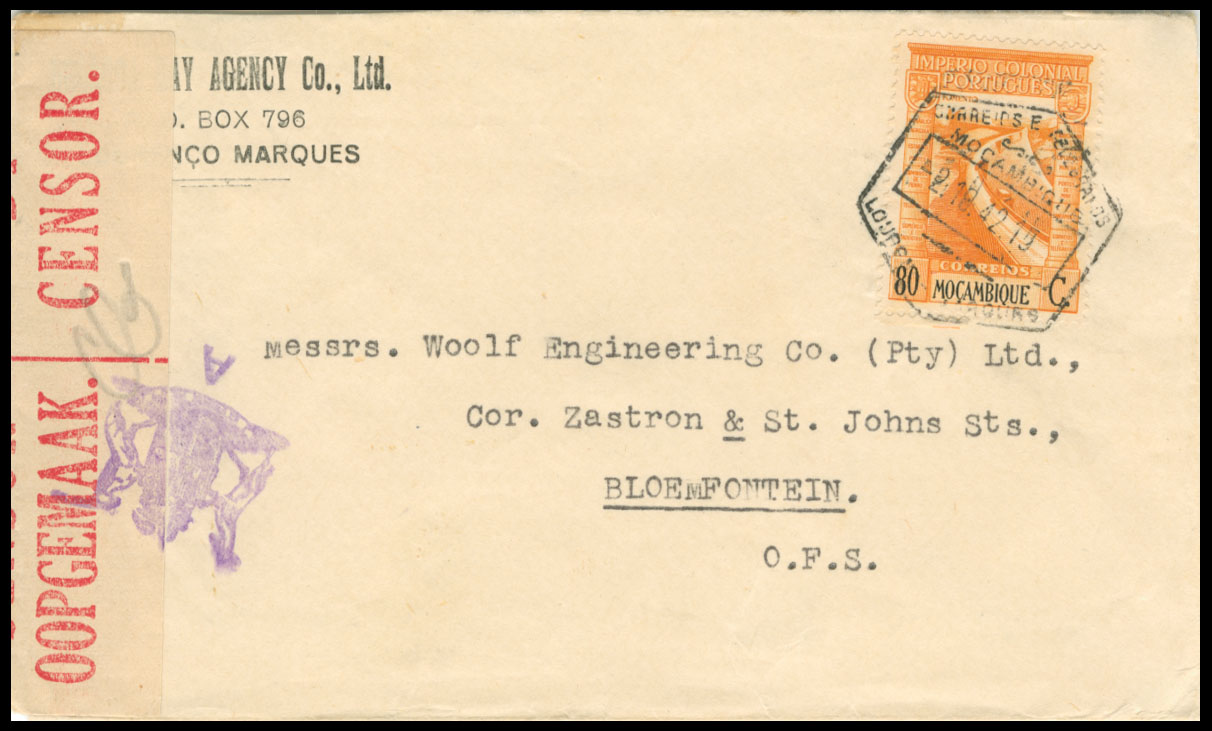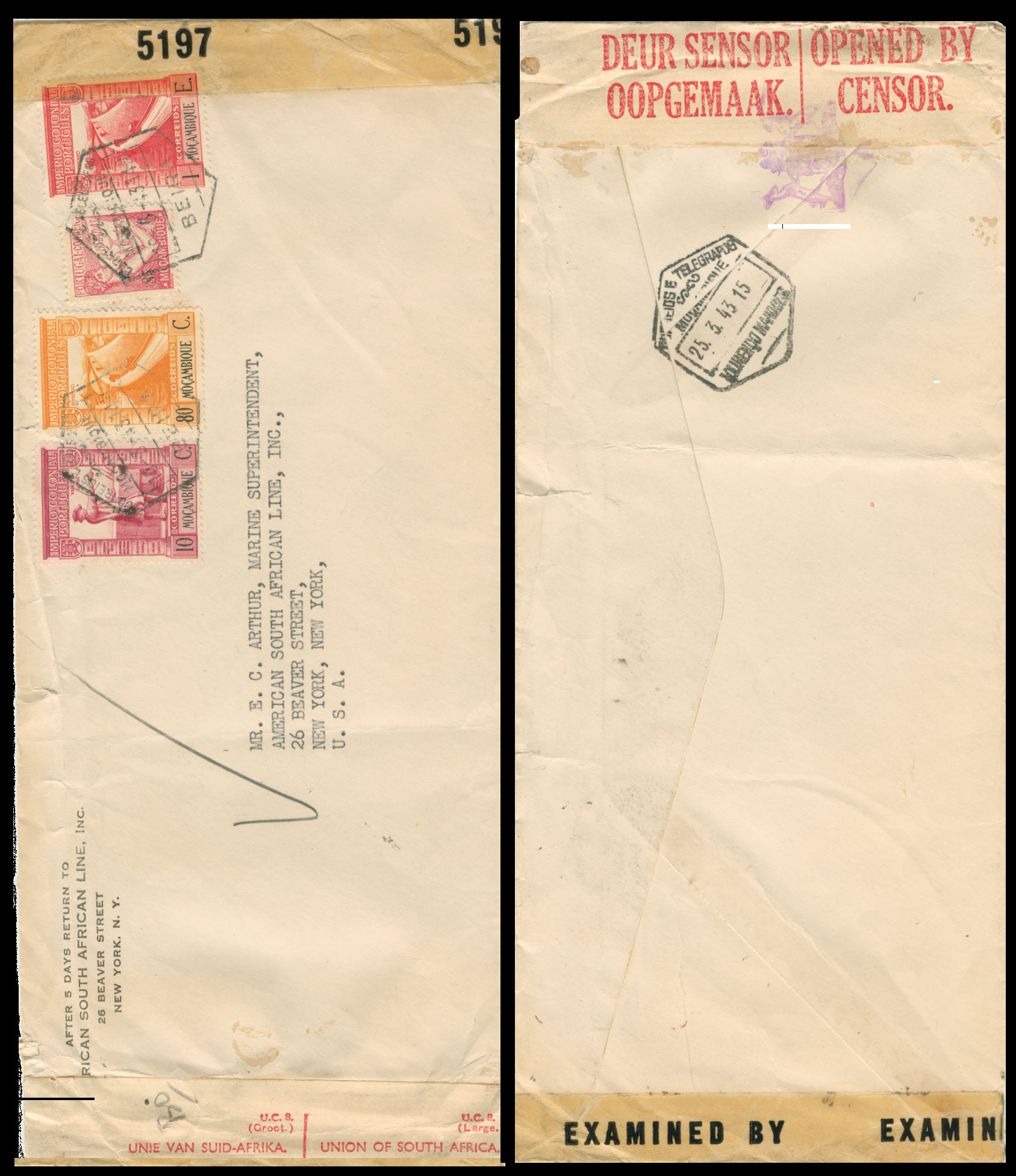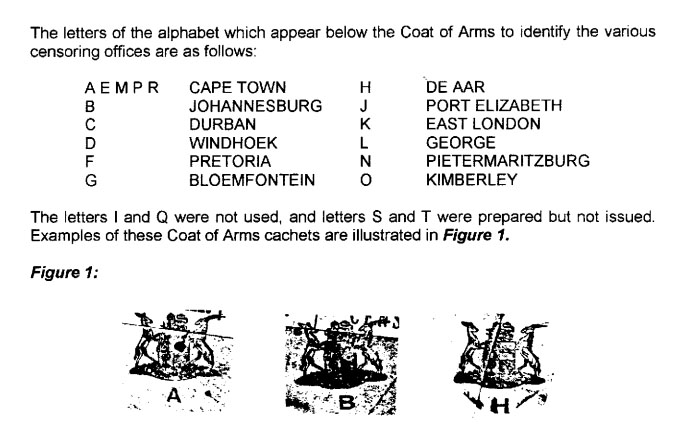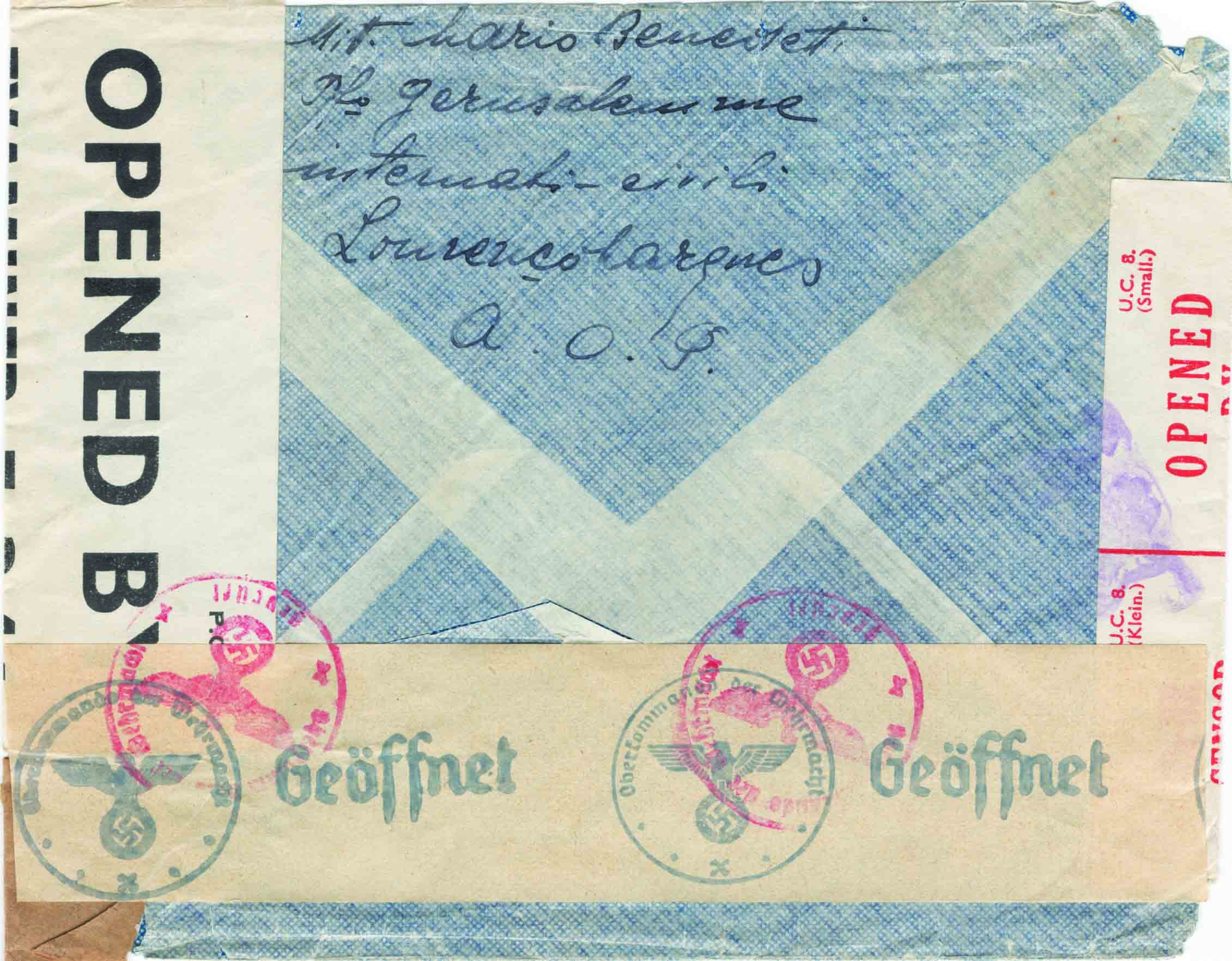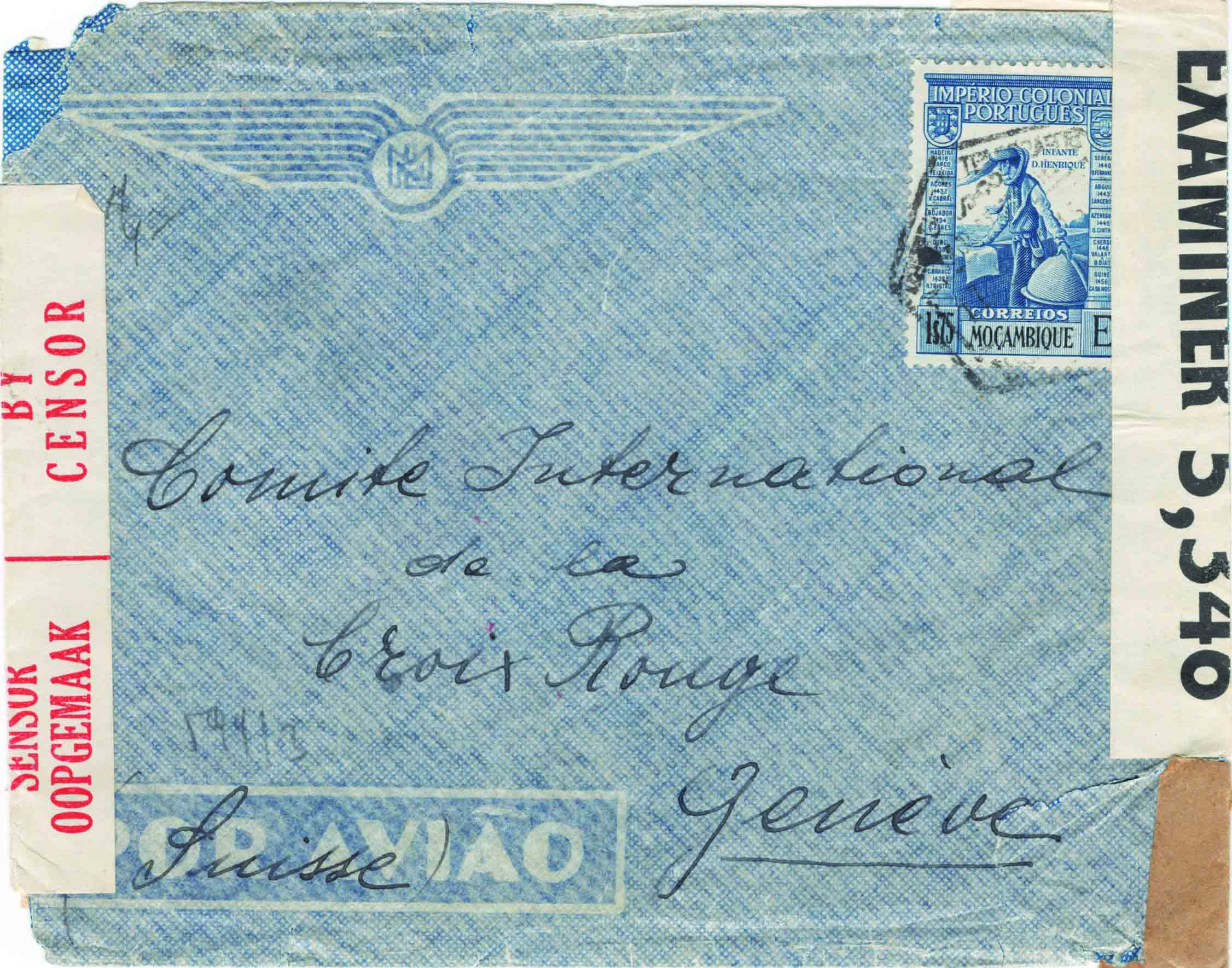Covers from Mozambique during WWII, how were the routes to Lisbon through South Africa
Quote from Lisbon on October 25, 2023, 7:15 pmGood afternoon
We would like to know how were the routes of covers sent from Mozambique during WWII, to Lisbon through South Africa
The censor tapes and censor marks.
Thank you
Good afternoon
We would like to know how were the routes of covers sent from Mozambique during WWII, to Lisbon through South Africa
The censor tapes and censor marks.
Thank you
Quote from Steve on October 26, 2023, 4:10 pmWelcome to SA Philately Club.
While I have some Mozambique covers (especially Mozambique company) I have not researched this field and will have to leave your questions to be answered by someone more expert than me.
There were 12 censorship centres in SA during WW2. Cape Town used the 'Coat of Arms A'. See two covers censored in Cape Town below. All Mozambique mail entering SA was subject to censorship. Because Portugal was neutral during World War II and because the Mozambique Channel was the main route for SA ammunition supplies to the North African battlefields, it was feared that German spies were active in Mozambique. When Mozambique mail went overseas by ship or by air from SA it was usually censored again on arrival. As stated, I am no expert but it seems to me that direct airmail using the old pre-war routes from SA via Cairo to Lisbon was probably suspended until the Axis forces were defeated in North Africa and the Medirreanean made safe for commercial aircraft. Prior to that there may have been a 'round-the-houses' service from West Africa run by Pan Am from Fisherman's Lake to the West Indies and then across the Atlantic to Portugal. Maybe!
South African Censor labels are usually red and bilingual, English and Afrikaans. British and US Censor Labels are usually black.
Welcome to SA Philately Club.
While I have some Mozambique covers (especially Mozambique company) I have not researched this field and will have to leave your questions to be answered by someone more expert than me.
There were 12 censorship centres in SA during WW2. Cape Town used the 'Coat of Arms A'. See two covers censored in Cape Town below. All Mozambique mail entering SA was subject to censorship. Because Portugal was neutral during World War II and because the Mozambique Channel was the main route for SA ammunition supplies to the North African battlefields, it was feared that German spies were active in Mozambique. When Mozambique mail went overseas by ship or by air from SA it was usually censored again on arrival. As stated, I am no expert but it seems to me that direct airmail using the old pre-war routes from SA via Cairo to Lisbon was probably suspended until the Axis forces were defeated in North Africa and the Medirreanean made safe for commercial aircraft. Prior to that there may have been a 'round-the-houses' service from West Africa run by Pan Am from Fisherman's Lake to the West Indies and then across the Atlantic to Portugal. Maybe!
South African Censor labels are usually red and bilingual, English and Afrikaans. British and US Censor Labels are usually black.
Uploaded files:Quote from Jamie Smith on October 27, 2023, 12:18 amSteve, I know mail was often sent by any means that made itself available. I wonder if the Royal Navy carried any mail when traveling up the west coast of Africa?
Steve, I know mail was often sent by any means that made itself available. I wonder if the Royal Navy carried any mail when traveling up the west coast of Africa?
Quote from Lisbon on October 27, 2023, 7:00 pmDear both
Thank you very much for your fast answer.
Is it possible to know where the censor centers were located and their numbers?
Cape Town used the A violet coat of arms on the tape. And the letters for the others.
The censor tapes were all of the same type?
Dear both
Thank you very much for your fast answer.
Is it possible to know where the censor centers were located and their numbers?
Cape Town used the A violet coat of arms on the tape. And the letters for the others.
The censor tapes were all of the same type?
Quote from Lisbon on October 27, 2023, 7:11 pmI forgot to say that the covers from Mozambique of 1943 have the Lisbon transit date stamp.
In 1941 and 42 no transit mark was found (Lisbon or other)
I forgot to say that the covers from Mozambique of 1943 have the Lisbon transit date stamp.
In 1941 and 42 no transit mark was found (Lisbon or other)
Quote from Steve on October 27, 2023, 10:09 pmSorry but I was unable to answer all your queries last night. As stated, I do not have the answers / knowledge you need to resolve them. Next weekend it is the SACS (South African Collectors' Society) conference in Meriden and I will ask around there. Today, however, there is the small matter of the Rugby World Cup final! Go Bokke!
I found this link on the PFSA (Philatelic Federation of South Africa.) web site which is free to use. (Google 'PFSA Stamps' and you should find the site okay.) Go to Resources / Explore Stamps. Below is a link in case you cannot get there. Sadly, there does not seem to be much on WW2 mail from Mozambique.
https://stampssa.africa/wp-content/uploads/2022/04/WW-2-Censorship-of-Civilian-Mail-during-WW2-in-SA-Tom-Mullins-web.pdf
As I understand it, you have covers sent from Mozambique during WWII, to Lisbon through South Africa. You want to know the route they took to get there. Your covers are from November 1941 to December 43, All but one has the South Africa censor tape with the Coat of Arms with letters A and E; (both Cape Town) and B (Johannesburg). You think that all your covers went by sea as all have a postage rate of 1$75 Escudos. I think it is likely your covers with letters A and E went by sea to Cape Town and B by rail to Johannesburg, then probably by rail to Cape Town or Durban. You say one cover arrived in Switzerland. This suggests flight or rail from a neutral country. Is the one from 1943 showing both South African and the British censor tape? Can you please post a few scans of your covers. Scan and save as JPG and Upload Files by Selecting and Opening them below, then Submitting them.You can show five scans at a time with a combined size below 5Mb (so don't scan higher than say 300 dpi).
Sorry but I was unable to answer all your queries last night. As stated, I do not have the answers / knowledge you need to resolve them. Next weekend it is the SACS (South African Collectors' Society) conference in Meriden and I will ask around there. Today, however, there is the small matter of the Rugby World Cup final! Go Bokke!
I found this link on the PFSA (Philatelic Federation of South Africa.) web site which is free to use. (Google 'PFSA Stamps' and you should find the site okay.) Go to Resources / Explore Stamps. Below is a link in case you cannot get there. Sadly, there does not seem to be much on WW2 mail from Mozambique.
As I understand it, you have covers sent from Mozambique during WWII, to Lisbon through South Africa. You want to know the route they took to get there. Your covers are from November 1941 to December 43, All but one has the South Africa censor tape with the Coat of Arms with letters A and E; (both Cape Town) and B (Johannesburg). You think that all your covers went by sea as all have a postage rate of 1$75 Escudos. I think it is likely your covers with letters A and E went by sea to Cape Town and B by rail to Johannesburg, then probably by rail to Cape Town or Durban. You say one cover arrived in Switzerland. This suggests flight or rail from a neutral country. Is the one from 1943 showing both South African and the British censor tape? Can you please post a few scans of your covers. Scan and save as JPG and Upload Files by Selecting and Opening them below, then Submitting them.You can show five scans at a time with a combined size below 5Mb (so don't scan higher than say 300 dpi).
Uploaded files:Quote from Lisbon on October 28, 2023, 11:08 amDear Steve
Thank you very much for your useful information and written fonts.
We have already written an article about a group of Italian internees in L Marques sending mail to the Red Cross in Switzerland.
Portugal, as a neutral country, was an open door to Europe.
As we have found more information in the Portuguese archives we intend to update the article,
Now it is more comprehensive which, was the route from L Marques to Durban and Cape Town, in the majority of cases
and from there by ship to Lisbon and from there by railway to Switzerland. The letters are all similar. We understand the censorship in Durban and Cape Town as major ports but why a letter was censored in Johannesburg?
We are going to try to attach a scan of the letter with South African red censor tape, black censor (British? where was it applied?), and German censor tape before entering Switzerland.
It will be a pleasure to include your name in the acknowledgments.
Luis and Eduardo Barreiros
Dear Steve
Thank you very much for your useful information and written fonts.
We have already written an article about a group of Italian internees in L Marques sending mail to the Red Cross in Switzerland.
Portugal, as a neutral country, was an open door to Europe.
As we have found more information in the Portuguese archives we intend to update the article,
Now it is more comprehensive which, was the route from L Marques to Durban and Cape Town, in the majority of cases
and from there by ship to Lisbon and from there by railway to Switzerland. The letters are all similar. We understand the censorship in Durban and Cape Town as major ports but why a letter was censored in Johannesburg?
We are going to try to attach a scan of the letter with South African red censor tape, black censor (British? where was it applied?), and German censor tape before entering Switzerland.
It will be a pleasure to include your name in the acknowledgments.
Luis and Eduardo Barreiros
Uploaded files:
Quote from Steve on November 22, 2023, 2:12 pmI apologise for taking so long to get back to you. I did not get any useful advice from the experts. None claimed to be Mozambique mail experts. The only answer I came back with was, variously "Airmail services were suspended for a large part of WW2 .... all Mozambique mail that did not go on a neutral ship to Europe (ie. all mail going on an Allied ship) went via Cape Town, (which explains the number of Cape Town censor marks you have) and .... some of this mail would have gone to Britain first before being forwarded to Portugal".
Looking at your cover - very nice - this is presumably an Axis internee, (who appears to be an Italian) - writing to the Red Cross in Switzerland begging some help. Although this is an Italian or Portuguese airmail letter, it appears to be going at the surface (ship) rate. Other than the South African, British and German censor marks, there is nothing to help us make more sense of its route.
I am disappointed that the SAPC cannot help you. Please let us know how you get on.
I apologise for taking so long to get back to you. I did not get any useful advice from the experts. None claimed to be Mozambique mail experts. The only answer I came back with was, variously "Airmail services were suspended for a large part of WW2 .... all Mozambique mail that did not go on a neutral ship to Europe (ie. all mail going on an Allied ship) went via Cape Town, (which explains the number of Cape Town censor marks you have) and .... some of this mail would have gone to Britain first before being forwarded to Portugal".
Looking at your cover - very nice - this is presumably an Axis internee, (who appears to be an Italian) - writing to the Red Cross in Switzerland begging some help. Although this is an Italian or Portuguese airmail letter, it appears to be going at the surface (ship) rate. Other than the South African, British and German censor marks, there is nothing to help us make more sense of its route.
I am disappointed that the SAPC cannot help you. Please let us know how you get on.
Quote from Lisbon on November 22, 2023, 5:23 pmDear Steve
Thank you very much for your commitment to this question.
Now the subject is much more clarified.
Our best regards.
Barreiros
Dear Steve
Thank you very much for your commitment to this question.
Now the subject is much more clarified.
Our best regards.
Barreiros

